Disentangling and Closing the Nutrient-Based Potato Yield Gap Using Integrated Nutrient Management Under Temperate Environments of Sub-Saharan Africa
Abstract
1. Introduction
2. Materials and Methods
2.1. Study Site Description
2.2. Plant Material
2.3. Experimental Factors, Design, Layout, and Procedure
2.4. Agronomic Practices
2.5. Data Collection
2.5.1. Phenological Development
2.5.2. Crop Growth and Yield
2.6. Data Analysis
3. Results and Discussion
3.1. Integrated Nutrient Management as the Fourth Principle of Conservation Agriculture
3.2. Applying Fertilisers Is a Crucial Bedrock of Integrated Management Strategy Under Marginal Environments
3.3. Incorporating Mulches Reduces Soil Nutrient Losses, Conferring a Potato Yield Advantage
3.4. Increasing Cultivar Season Length Renders a Fertiliser Uptake Advantage Under Integrated Nutrient Management
3.5. Effectiveness of Integrated Nutrient Management in Bridging the Nutrient-Driven Potato Yield Gap in Sub-Saharan Africa
3.6. Fertilizer-Driven Variations in Potato Yield, Canopy Development, Biomass Accumulation, and Growing Length
3.7. Mulch-Induced Changes in Potato Yield, Canopy Cover, Biomass, and Growth Duration
3.8. Genotypic Variation in Potato Yield, Canopy Development, Biomass, and Crop Maturity
4. Conclusions
Author Contributions
Funding
Data Availability Statement
Acknowledgments
Conflicts of Interest
References
- Farooq, M. Conservation Agriculture and Sustainable Development Goals. Pak. J. Agric. Sci. 2023, 60, 291–298. [Google Scholar] [CrossRef]
- Lefe, Y.D.H.; Asare-Nuamah, P.; Njong, A.M.; Kondowe, J.; Musakaruka, R.R. Does Climate Variability Matter in Achieving Food Security in Sub-Saharan Africa? Environ. Chall. 2024, 15, 100870. [Google Scholar]
- Phalan, B.; Green, R.; Balmford, A. Closing Yield Gaps: Perils and Possibilities for Biodiversity Conservation. Philosophical. Trans. R. Soc. B 2014, 369, 20120285. [Google Scholar] [CrossRef]
- Mijena, G.M.; Gedebo, A.; Beshir, H.M.; Haile, A. Ensuring Food Security of Smallholder Farmers Through Improving Productivity and Nutrition of Potato. J. Agric. Food Res. 2022, 10, 100400. [Google Scholar] [CrossRef]
- Muthoni, J.; Shimelis, H. An Overview of Potato Production in Africa. In Potato Production Worldwide; Çalişkan, M.E., Bakhsh, A., Jabran, K., Eds.; Academic Press: Cambridge, MA, USA, 2023; pp. 435–456. [Google Scholar]
- Phungula, N.P.M.; Hadebe, S.T.; Schulte-Geldermann, E.; Sithole, L.; Ngobese, N.Z. Yield and Growth Response of Selected Potato Cultivars to Different Mulch and Fungicide Applications, and Various Localities Under Rainfed Conditions. Potato Res. 2024, 1–23. [Google Scholar] [CrossRef]
- Reynolds, T.W.; Waddington, S.R.; Anderson, C.L.; Chew, A.; True, Z.; Cullen, A. Environmental Impacts and Constraints Associated with the Production of Major Food Crops in Sub-Saharan Africa and South Asia. Food Secur. 2015, 7, 795–822. [Google Scholar] [CrossRef]
- Biramo, G. The Role of Integrated Nutrient Management System for Improving Crop Yield and Enhancing Soil Fertility under Small Holder Farmers in Sub-Saharan Africa: A Review Article. Mod. Concepts Dev. Agron. 2018, 2, 221–229. [Google Scholar] [CrossRef]
- Ongoma, V.; Brouziyne, Y.; Bouras, E.H.; Chehbouni, A. Closing yield gap for sustainable food security in sub-Saharan Africa—Progress, challenges, and opportunities. Front. Agron. 2025, 7, 1572061. [Google Scholar] [CrossRef]
- Svubure, O.; Struik, P.; Haverkort, A.; Steyn, J. Yield Gap Analysis and Resource Footprints of Irish Potato Production Systems in Zimbabwe. Field Crops Res. 2015, 178, 77–90. [Google Scholar] [CrossRef]
- Mpandeli, S.; Maponya, P. Constraints and Challenges Facing the Small-Scale Farmers in Limpopo Province, South Africa. J. Agric. Sci. 2014, 6, 135–143. [Google Scholar] [CrossRef]
- Dimkpa, C.; Adzawla, W.; Pandey, R.; Atakora, W.K.; Kouame, A.K.; Jemo, M.; Bindraban, P.S. Fertilizers for Food and Nutrition Security in Sub-Saharan Africa: An Overview of Soil Health Implications. Front. Soil Sci. 2023, 3, 1123931. [Google Scholar] [CrossRef]
- Holden, S.T. Fertilizer and Sustainable Intensification in sub-Saharan Africa. Glob. Food Secur. 2018, 18, 20–26. [Google Scholar] [CrossRef]
- Leitner, S.; Pelster, D.E.; Werner, C.; Merbold, L.; Baggs, E.M.; Mapanda, F.; Bahl, K.B. Closing Maize Yield Gaps in sub-Saharan Africa Will Boost Soil N2O Emissions. Curr. Opin. Environ. Sustain. 2020, 47, 95–105. [Google Scholar] [CrossRef]
- Chivenge, P.; Zingore, S.; Ezui, K.S.; Njoroge, S.; Bunquin, M.A.; Dobermann, A.; Saito, K. Progress in research on site-specific nutrient management for smallholder farmers in sub-Saharan Africa. Field Crops Res. 2022, 281, 108503. [Google Scholar] [CrossRef]
- Tamene, L.; Mesfin, T.; Tibebe, D.; Abera, W.; Desta, G.; Liben, F.; Agegnehu, G.; Tigabie, A.; Legesse, G.; Chernet, M.; et al. Closing Yield Gaps in Ethiopia: Leveraging Data-Driven Approaches to Optimize Fertilizer Use and Soil Health (Periodic Table of Food Initiative Technical Report); The Alliance of Bioversity International and CIAT: Addis Ababa, Ethiopia, 2024; pp. 1–17. [Google Scholar]
- Trisos, C.H.; Adelekan, I.O.; TOTIN, E.; Ayanlade, A.; Efitre, J.; Gemeda, A.; Kalaba, K.; Lennard, C.; Masao, C.; Mgaya, Y.; et al. Chapter 9: Africa. In Climate Change 2022: Impacts, Adaptation, and Vulnerability. Contribution of Working Group II to the Sixth Assessment Report of the Intergovernmental Panel on Climate Change; Pörtner, H.-O., Roberts, D.C., Tignor, M., Poloczanska, E.S., Mintenbeck, K., Alegría, A., Craig, M., Langsdorf, S., Löschke, S., Möller, V., et al., Eds.; Cambridge University Press: Cambridge, UK; New York, NY, USA, 2022; pp. 1285–1455. [Google Scholar]
- Kidane, B.; Urugo, M.M.; Hirpha, H.H.; Paulos, T.; Hundea, W.; Tessema, F. Nutritional Challenges of Staple Crops Due to Increasing Atmospheric Carbon Dioxide Levels: Case of sub-Saharan Africa. J. Agric. Food Res. 2025, 19, 101592. [Google Scholar] [CrossRef]
- Ayiti, O.E.; Babalola, O.O. Factors Influencing Soil Nitrification Process and the Effect on Environment and Health. Front. Sustain. Food Syst. 2022, 6, 821994. [Google Scholar] [CrossRef]
- Obe, O.B.; Morakinyo, T.E.; Mills, G. Assessing Heat Risk in a Sub-Saharan African Humid City, Lagos, Nigeria, Using Numerical Modelling and Open-Source Geospatial Socio-Demographic Datasets. City Environ. Interact. 2023, 20, 100128. [Google Scholar]
- Ayanlade, A.; Oluwaranti, A.; Ayanlade, O.S.; Borderon, M.; Sterly, H.; Sakdapolrak, P.; Jegede, M.O.; Weldemariam, L.F.; Ayinde, A.F. Extreme Climate Events in Sub-Saharan Africa: A Call for Improving Agricultural Technology Transfer to Enhance Adaptive Capacity. Clim. Serv. 2022, 27, 100311. [Google Scholar] [CrossRef]
- Fan, X.H.; Li, Y.C.; Kumar, A.A. Effects of Temperature and Soil Type on Ammonia Volatilization from Slow-Release Nitrogen Fertilizers. Commun. Soil Sci. Plant Anal. 2011, 42, 1111–1122. [Google Scholar] [CrossRef]
- Tully, K.; Sullivan, C.; Weil, R.; Sanchez, P. The State of Soil Degradation in sub-Saharan Africa: Baselines, Trajectories, and Solutions. Sustainability 2015, 7, 6523–6552. [Google Scholar] [CrossRef]
- Kihara, J.; Bolo, P.; Kinyua, M.; Nyawira, S.; Sommer, R. Soil Health and Ecosystem Services: Lessons from sub-Sahara Africa (SSA). Geoderma 2020, 370, 114342. [Google Scholar] [CrossRef]
- Mangalassery, S.; Kalaivanan, D.; Philip, P.S. Effect of Inorganic Fertilizers and Organic Amendments on Soil Aggregation and Biochemical Characteristics in a Weathered Tropical Soil. Soil Tillage Res. 2018, 187, 144–151. [Google Scholar] [CrossRef]
- Nathan, O.O.; Monicah, M.; Jayne, M.N.; Isaya, S.; George, N.; Daniel, M.N. Nutrient and Organic Carbon Losses by Erosion, and Their Economic and Environmental Implications in the Drylands of Kenya. Environ. Chall. 2022, 7, 100519. [Google Scholar] [CrossRef]
- Vanlauwe, B.; Wendt, J.; Giller, K.E.; Corbeels, M.; Gerard, B.; Nolte, C. A Fourth Principle Is Required to Define Conservation Agriculture in sub-Saharan Africa: The Appropriate Use of Fertilizer to Enhance Crop Productivity. Field Crops Res. 2014, 155, 10–13. [Google Scholar] [CrossRef]
- Lal, R. Societal value of soil carbon. J. Soil Water Conserv. 2014, 69, 186A–192A. [Google Scholar] [CrossRef]
- Lal, R. Sequestering carbon and increasing productivity by conservation agriculture. J. Soil Water Conserv. 2015, 70, 55A–62A. [Google Scholar] [CrossRef]
- Sommer, R.; Thierfelder, C.; Tittonell, P.; Hove, L.; Mureithi, J.; Mkomwa, S. Fertilizer Use Should Not Be a Fourth Principle to Define Conservation Agriculture. Field Crops Res. 2014, 169, 145–148. [Google Scholar] [CrossRef]
- Soil Classification Working Group. Soil Classification: A Natural and Anthropogenic System for South Africa; Agricultural Research Council, Institute for Soil, Climate and Water (ARC-ISCW): Pretoria, South Africa, 2018. [Google Scholar]
- Wesgrow. Our potato Varieties. 2020. Available online: https://wesgrow.co.za (accessed on 19 March 2025).
- Ngobese, N.M.; Naidoo, M.; Workneh, T.S. Yield and Tuber Quality Performance of Eight European Potato (Solanum tuberosum L.) Cultivars in a Short-Day Temperate Climate. J. Cent. Eur. Agric. 2022, 23, 807–816. [Google Scholar] [CrossRef]
- Ngxabi, A.M.; Tshikhudo, P.P.; Mudau, F.N. Use of Indigenous Knowledge to Control Potato Pests in Umzimkhulu Local Municipality. S. Afr. J. Inf. Manag. 2023, 25, a1640. [Google Scholar] [CrossRef]
- Mthembu, S.G.; Magwaza, L.S.; Mashilo, J.; Mditshwa, A.; Odindo, A. Drought Tolerance Assessment of Potato (Solanum Tuberosum L.) Genotypes at Different Growth Stages, Based on Morphological and Physiological Traits. Agric. Water Manag. 2022, 261, 107361. [Google Scholar] [CrossRef]
- Pieczynski, M.; Marczewski, W.; Hennig, J.; Dolata, J.; Bielewicz, D.; Piontek, P.; Wyrzykowska, A.; Krusiewicz, D.; Strzelczyk-Zyta, D.; Konopka-Postupolska, D.; et al. Down-Regulation of CBP80 Gene Expression as a Strategy to Engineer a Drought-Tolerant Potato. Plant Biotechnol. J. 2013, 11, 459–469. [Google Scholar] [CrossRef]
- Groen, M. Potato Variety Spotlight: Mondial Main Potato Board. 2020. Available online: https://www.mainepotatoes.com (accessed on 19 March 2024).
- FERTASA (Fertilizer Association of Southern Africa). Fertilizer Handbook, 7th ed.; FERTASA: Lynnwood Ridge, South Africa, 2016. [Google Scholar]
- Franke, A.; Steyn, J.; Ranger, K.; Haverkort, A. Developing Environmental Principles, Criteria, Indicators and Norms for Potato Production in South Africa Through Field Surveys and Modelling. Agric. Syst. 2010, 104, 297–306. [Google Scholar] [CrossRef][Green Version]
- Quiroz, R.; Harahagazwe, D.; Condori, B.; Barreda, C.; de Mendiburu, F.; Amele, A.; Anthony, D.; Atieno, E.; Bararyenya, A.; Byarugaba, A.A.; et al. Potato Yield Gap Analysis in SSA Through Participatory Modeling: Optimizing the Value of Historical Breeding Trial Data. In Proceedings of the Yield Gap Analysis and Crop Modeling Workshop, Addis Ababa, Ethiopia, 14–18 October 2013. [Google Scholar]
- Franke, A.C.; Machakaire, A.T.B.; Mukiibi, A.; Kayes, M.J.; Swanepoel, P.A.; Steyn, J.M. In-Field Assessment of the Variability in Water and Nutrient Use Efficiency Among Potato Farmers in a Semi-Arid Climate. Front. Sustain. Food Syst. 2023, 7, 1222870. [Google Scholar] [CrossRef]
- Zebarth, B.J.; Rosen, C.J. Research Perspective on Nitrogen Bmp Development for Potato. Am. J. Potato Res. 2007, 84, 3–18. [Google Scholar] [CrossRef]
- Horneck, D.; Rosen, C. Measuring Nutrient Accumulation Rates of Potatoes—Tools for Better Management. Better Crops 2008, 92, 4–6. [Google Scholar]
- Koch, M.; Naumann, M.; Pawelzik, E.; Gransee, A.; Thiel, H. The Importance of Nutrient Management for Potato Production Part I: Plant Nutrition and Yield. Potato Res. 2020, 63, 97–119. [Google Scholar] [CrossRef]
- Saxton, K.E.; Rawls, W.J. Soil Water Characteristic Estimates by Texture and Organic Matter for Hydrologic Solutions. Soil Sci. Soc. Am. J. 2006, 70, 1569–1578. [Google Scholar] [CrossRef]
- Patrignani, A.; Ochsner, T. Canopeo: A Powerful New Tool for Measuring Fractional Green Canopy Cover. Agron. J. 2015, 107, 2312–2320. [Google Scholar] [CrossRef]
- Araya, T.; Ochsner, T.E.; Mnkeni, P.N.S.; Hounkpatin, K.O.L.; Amelung, W. Challenges and Constraints of Conservation Agriculture Adoption in Smallholder Farms in sub-Saharan Africa: A Review. Int. Soil Water Conserv. Res. 2024, 12, 828–843. [Google Scholar] [CrossRef]
- Yadav, R.; Panghal, V.P.S.; Prakash, R. Response of Potato Varieties to Nitrogen Fertilization for Growth, Yield and Nutrient Uptake. Res. Sq. 2023, 1, 1–10. [Google Scholar]
- Anas, M.; Liao, F.; Verma, K.K.; Sarwar, M.A.; Mahmood, A.; Chen, Z.L.; Li, Q.; Zeng, X.P.; Liu, Y.; Li, Y.R. Fate of Nitrogen in Agriculture and Environment: Agronomic, Eco-Physiological and Molecular Approaches to Improve Nitrogen Use Efficiency. Biol. Res. 2020, 53, 1–20. [Google Scholar] [CrossRef] [PubMed]
- Gatti, N.; Cecil, M.; Baylis, K.; Estes, L.; Blekking, J.; Heckelei, T.; Vergopolan, N.; Evans, T. Is Closing the Agricultural Yield Gap a “Risky” Endeavor? Agric. Syst. 2023, 208, 103657. [Google Scholar] [CrossRef]
- Tittonell, P.; Vanlauwe, B.; Corbeels, M.; Giller, K.E. Yield Gaps, Nutrient Use Efficiencies and Response to Fertilizers by Maize Across Heterogeneous Smallholder Farms of Western Kenya. Plant Soil 2008, 313, 19–37. [Google Scholar] [CrossRef]
- Mupangwa, W.; Chipindu, L.; Ncube, B.; Mkuhlani, S.; Nhantumbo, N.; Masvaya, E.; Ngwira, A.; Moeletsi, M.; Nyagumbo, I.; Liben, F. Temporal Changes in Minimum and Maximum Temperatures at Selected Locations of Southern Africa. Climate 2023, 11, 84. [Google Scholar] [CrossRef]
- Siman, F.C.; Andrade, F.V.; Passos, R.R. Nitrogen Fertilizers and NH3 Volatilization: Effect of Temperature and Soil Moisture. Commun. Soil Sci. Plant Anal. 2020, 51, 1283–1292. [Google Scholar] [CrossRef]
- Wang, Y.; Zhang, R.; Li, S.; Guo, X.; Li, Q.; Hui, X.; Wang, Z.; Wang, H. An Evaluation of Potato Fertilization and the Potential of Farmers to Reduce the Amount of Fertilizer Used Based on Yield and Nutrient Requirements. Agronomy 2024, 14, 612. [Google Scholar] [CrossRef]
- Dadrasi, A.; Weinzettel, J.; Wei, G.; Vačkářová, D.; Frouz, J. Closing Global Yield Gap of Rainfed Wheat by Optimizing Nitrogen and Phosphorus Inputs. Sci. Total Environ. 2025, 977, 179367. [Google Scholar] [CrossRef]
- Getaneh, S.; Molla, E.; Abera, D. Effects of Integrated Fertilizer Application on Soil Properties and Yield of Maize (Zea mays L.) on Nitisols in Pawe District, Northwestern Ethiopia. J. Agric. Environ. Sci. 2024, 9, 13–32. [Google Scholar] [CrossRef]
- Tsujimoto, Y.; Tanaka, A.; Rakotoson, T. Sequential Micro-Dose Fertilization Strategies for Rice Production: Improved Fertilizer Use Efficiencies and Yields on P-Deficient Lowlands in the Tropical Highlands. Eur. J. Agron. 2021, 131, 126381. [Google Scholar] [CrossRef]
- Torma, S.; Vilček, J.; Lošák, T.; Kužel, S.; Martensson, A. Residual Plant Nutrients in Crop Residues—An Important Resource. Acta Agric. Scand. Sect. B—Soil Plant Sci. 2017, 68, 358–366. [Google Scholar] [CrossRef]
- Sharma, L.K.; Bali, S.K. A Review of Methods to Improve Nitrogen Use Efficiency in Agriculture. Sustainability 2018, 10, 51. [Google Scholar] [CrossRef]
- Chen, H.; Liu, J.; Zhang, A.; Chen, J.; Cheng, G.; Sun, B.; Pi, X.; Dyck, M.; Si, B.; Zhao, Y.; et al. Effects of Straw and Plastic Film Mulching on Greenhouse Gas Emissions in Loess Plateau, China: A Field Study of Two Consecutive Wheat-Maize Rotation Cycles. Sci. Total Environ. 2017, 579, 814–824. [Google Scholar] [CrossRef] [PubMed]
- Wang, L.; Coulter, J.A.; Palta, J.A.; Xie, J.; Luo, Z.; Li, L.; Carberry, P.; Li, Q.; Deng, X. Mulching-Induced Changes in Tuber Yield and Nitrogen Use Efficiency in Potato in China: A Meta-Analysis. Agronomy 2019, 9, 793. [Google Scholar] [CrossRef]
- Tian, Y.; Tian, L.; Wang, F.; Shi, X.; Shi, F.; Hao, X.; Li, N.; Chenu, K.; Luo, H.; Yang, G. Optimizing Nitrogen Application Improves Its Efficiency by Higher Allocation in Bolls of Cotton Under Drip Fertigation. Field Crops Res. 2023, 298, 108968. [Google Scholar] [CrossRef]
- Johansen, T.J.; Thomsen, M.G.; Løes, A.K.; Riley, H. Root Development in Potato and Carrot Crops—Influences of Soil Compaction. Acta Agric. Scand. Sect. B—Soil Plant Sci. 2015, 65, 182–192. [Google Scholar] [CrossRef]
- Lobell, D.B.; Cassman, K.G.; Field, C.B. Crop Yield Gaps: Their Importance, Magnitudes, and Causes. Annu. Rev. Environ. Resour. 2009, 34, 179–204. [Google Scholar] [CrossRef]
- Mangani, T.; Mangani, R.; Chirima, G.; Khomo, L.; Truter, W. Using Mulching to Reduce Soil Surface Temperature to Facilitate Grass Production. Heliyon 2022, 8, e12284. [Google Scholar] [CrossRef]
- Kumar, S.S.; Wani, O.A.; Prasad, B.; Banuve, A.; Mua, P.; Sharma, A.C.; Prasad, S.; Malik, A.R.; El-Hendawy, S.; Mattar, M.A. Effects of Mulching on Soil Properties and Yam Production in Tropical Region. Sustainability 2024, 16, 7787. [Google Scholar] [CrossRef]
- Naab, J.B.; Mahama, G.Y.; Yahaya, I.; Prasad, P.V.V. Conservation Agriculture Improves Soil Quality, Crop Yield, and Incomes of Smallholder Farmers in North Western Ghana. Front. Plant Sci. 2017, 8, 996. [Google Scholar] [CrossRef]
- Iqbal, R.; Raza, M.A.S.; Valipour, M.; Saleem, M.F.; Zaheer, M.S.; Ahmad, S.; Toleikiene, M.; Haider, I.; Aslam, M.U.; Nazar, M.A. Potential Agricultural and Environmental Benefits of Mulches—A Review. Bull. Natl. Res. Cent. 2020, 44, 75. [Google Scholar] [CrossRef]
- Singh, D.; Sandhu, S.K. Effect of Climate Variability on Potato Yield Under Different Agroclimatic Zones of Punjab. J. Potato 2022, 49, 159–166. [Google Scholar]
- Kouame, K.P.; Agrahari, R.K.; Konjengbam, N.S.; Koyama, H.; Kobayashi, Y. Ability of Nutrient Management and Molecular Physiology Advancements to Overcome Abiotic Stress: A study on sub-Saharan African Crops. Agriculture 2024, 14, 285. [Google Scholar] [CrossRef]
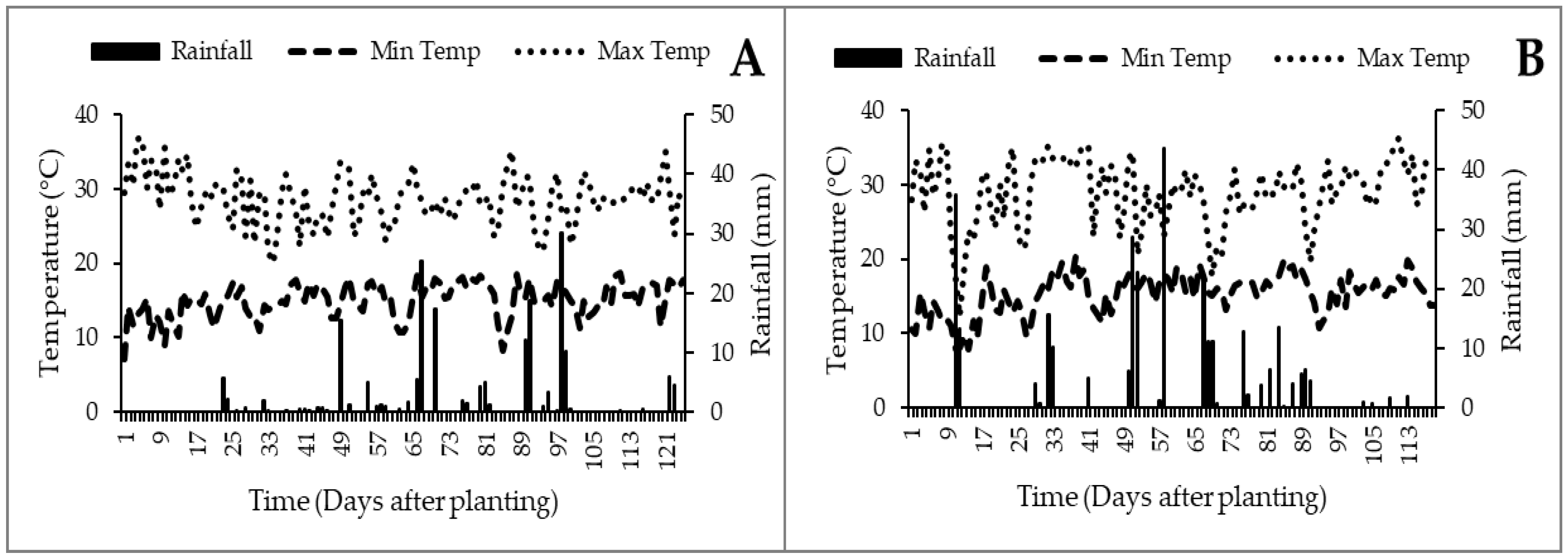
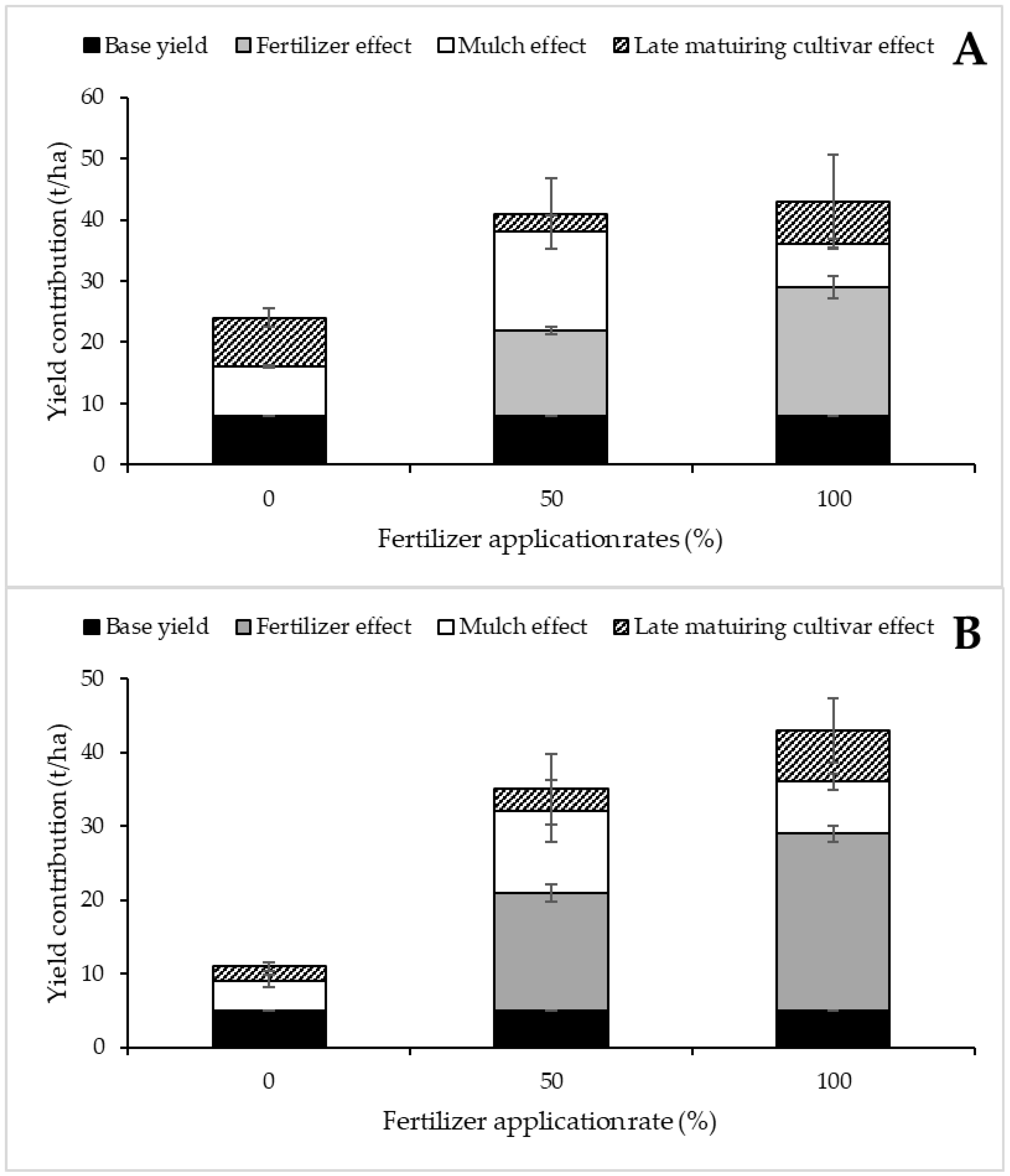
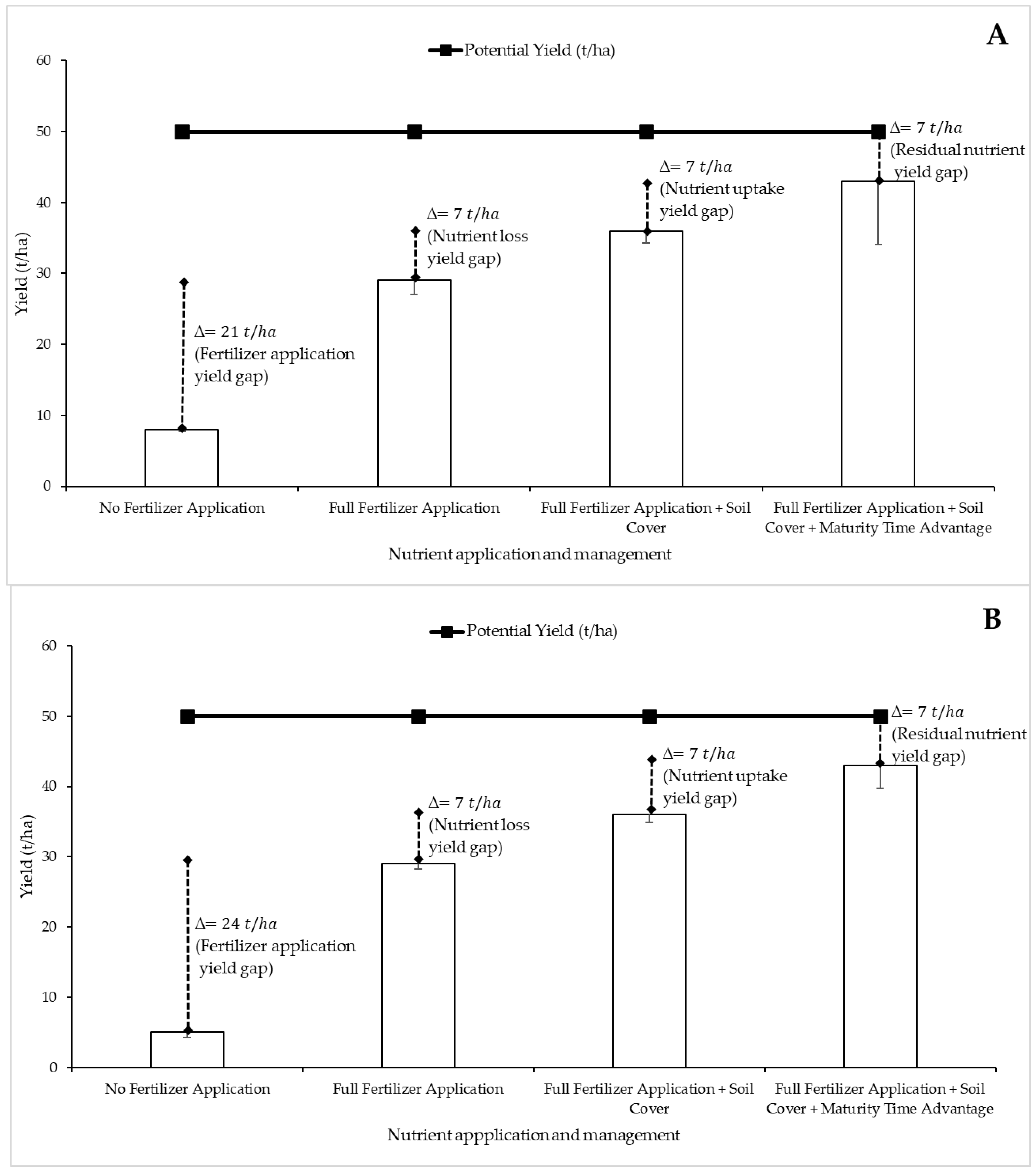
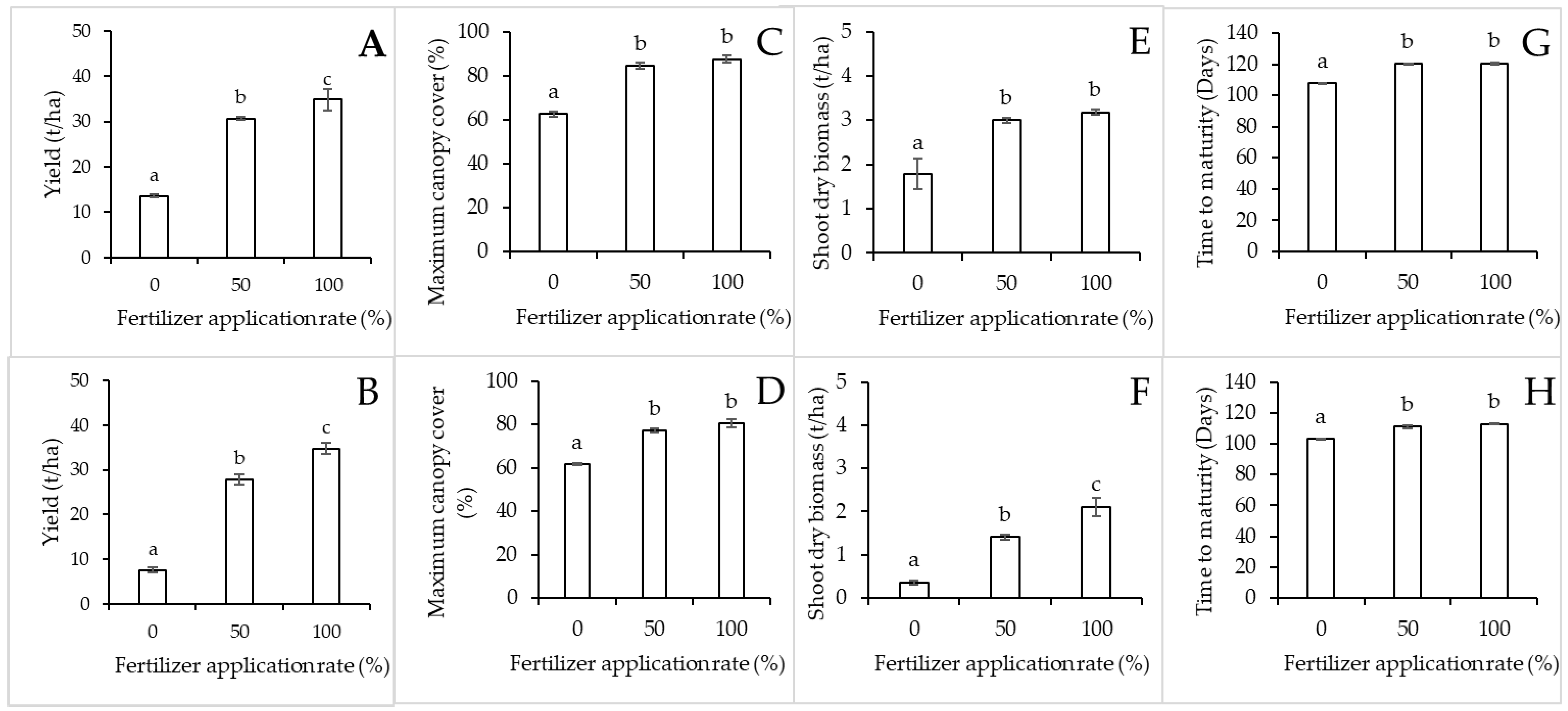
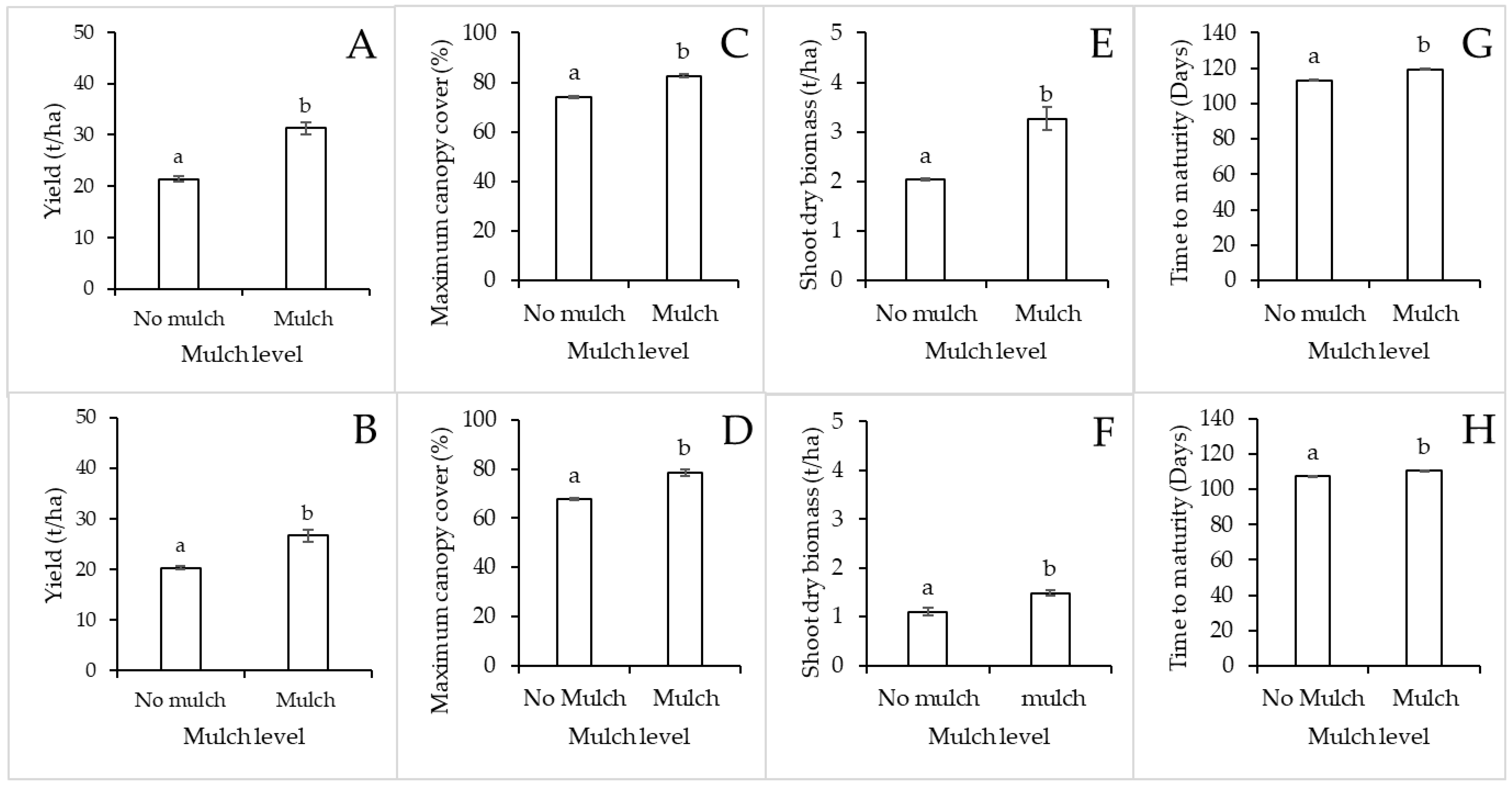
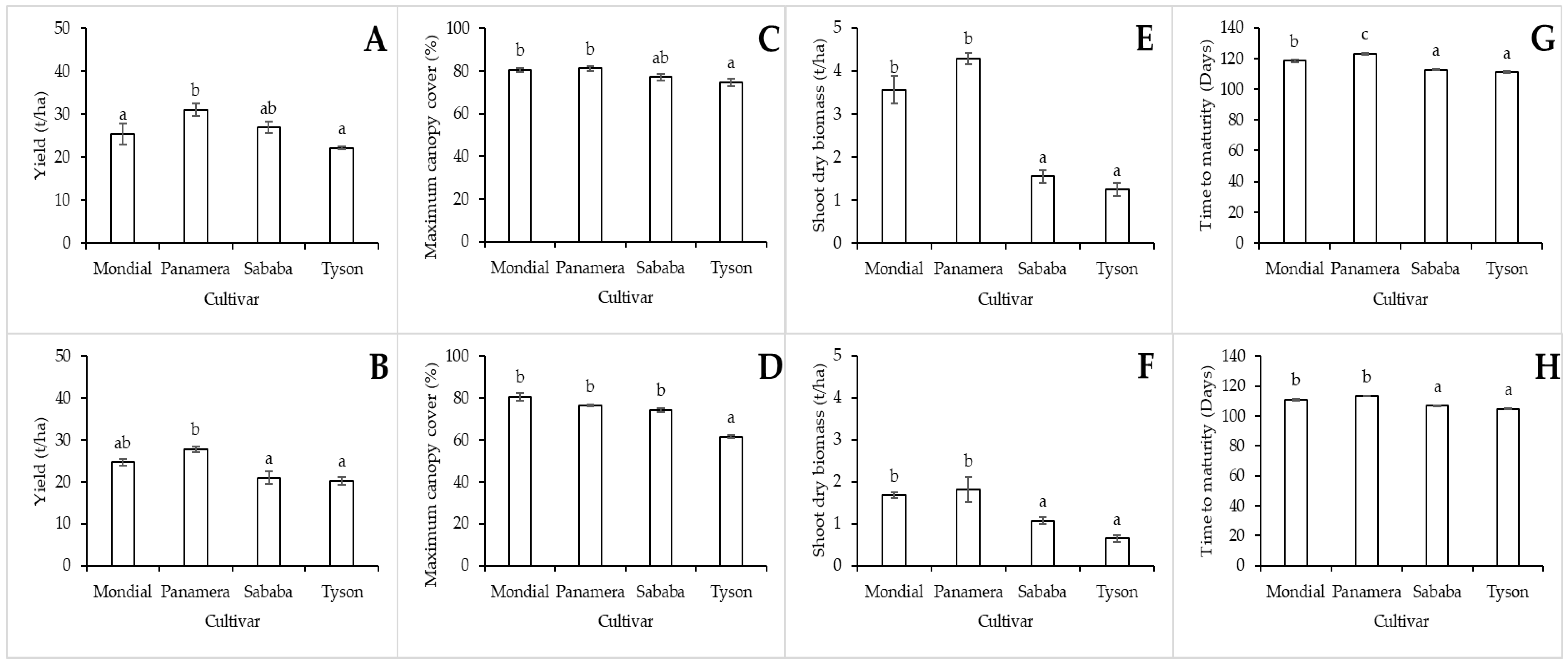
| Cultivar | Time to Maturity (days) | Growing Cycle | * Nutrient Uptake Advantage (days) | Nutrient Response Characteristics |
|---|---|---|---|---|
| Sababa | 100–105 | Early maturing | 0 | - |
| Mondial | 110–115 | Mid-late maturing | 10 | Sensitive to nitrogen spikes |
| Tyson | 105–110 | Mid maturing | 5 | Low nitrogen requirement (<120 kg N/ha) |
| Panamera | 115–120 | Late maturing | 15 | - |
| Nutrient | Soil Test | Crop Required | Deficit | 100% Fertilizer Application Rate | 50% Fertilizer Application Rate | Total Soil Available Nutrients | ||
|---|---|---|---|---|---|---|---|---|
| 100% | 50% | Control | ||||||
| ----------------------------------------------------------------------kg/ha---------------------------------------------------------------------- | ||||||||
| Season 2022/23 | ||||||||
| N | 60 | 240 | 180 | 240 | 120 | 300 | 180 | 60 |
| P | 75 | 155 | 80 | 80 | 40 | 155 | 115 | 75 |
| K | 220 | 320 | 100 | 100 | 50 | 320 | 270 | 220 |
| Season 2023/24 | ||||||||
| N | 30 | 240 | 210 | 240 | 120 | 270 | 150 | 30 |
| P | 5 | 155 | 150 | 150 | 75 | 155 | 80 | 5 |
| K | 80 | 320 | 260 | 260 | 130 | 340 | 210 | 80 |
| Fertilizer Application Rate (%) | Yield (t/ha) | Yield Gain/Loss (t/ha) | Mulch Application | Late Maturing Cultivar | Total Yield Gains | ||
| Yield (t/ha) | Yield Gain/Loss (t/ha) | Yield (t/ha) | Yield Gain/Loss(t/ha) | ||||
| 0 | 8 | +0 | 16 | +8 | 24 | +8 | +16 |
| 50 | 22 | +14 | 38 | +16 | 41 | +3 | +33 |
| 100 | 29 | +21 | 36 | +7 | 43 | +7 | +35 |
| Fertilizer Application Rate (%) | Yield (t/ha) | Yield Gain/Loss (t/ha) | Mulch Application | Late Maturing Cultivar | Total Yield Gains | ||
| Yield (t/ha) | Yield Gain/Loss (t/ha) | Yield | Yield Gain/Loss | ||||
| 0 | 5 | +0 | 9 | +4 | 11 | +2 | +6 |
| 50 | 21 | +16 | 32 | +11 | 35 | +3 | +30 |
| 100 | 29 | +24 | 36 | +7 | 43 | +7 | +38 |
Disclaimer/Publisher’s Note: The statements, opinions and data contained in all publications are solely those of the individual author(s) and contributor(s) and not of MDPI and/or the editor(s). MDPI and/or the editor(s) disclaim responsibility for any injury to people or property resulting from any ideas, methods, instructions or products referred to in the content. |
© 2025 by the authors. Licensee MDPI, Basel, Switzerland. This article is an open access article distributed under the terms and conditions of the Creative Commons Attribution (CC BY) license (https://creativecommons.org/licenses/by/4.0/).
Share and Cite
Ntuli, J.; Ngobese, N.Z.; Sithole, L.; Hadebe, S. Disentangling and Closing the Nutrient-Based Potato Yield Gap Using Integrated Nutrient Management Under Temperate Environments of Sub-Saharan Africa. Horticulturae 2025, 11, 835. https://doi.org/10.3390/horticulturae11070835
Ntuli J, Ngobese NZ, Sithole L, Hadebe S. Disentangling and Closing the Nutrient-Based Potato Yield Gap Using Integrated Nutrient Management Under Temperate Environments of Sub-Saharan Africa. Horticulturae. 2025; 11(7):835. https://doi.org/10.3390/horticulturae11070835
Chicago/Turabian StyleNtuli, Jabulani, Nomali Ziphorah Ngobese, Lucky Sithole, and Sandile Hadebe. 2025. "Disentangling and Closing the Nutrient-Based Potato Yield Gap Using Integrated Nutrient Management Under Temperate Environments of Sub-Saharan Africa" Horticulturae 11, no. 7: 835. https://doi.org/10.3390/horticulturae11070835
APA StyleNtuli, J., Ngobese, N. Z., Sithole, L., & Hadebe, S. (2025). Disentangling and Closing the Nutrient-Based Potato Yield Gap Using Integrated Nutrient Management Under Temperate Environments of Sub-Saharan Africa. Horticulturae, 11(7), 835. https://doi.org/10.3390/horticulturae11070835









